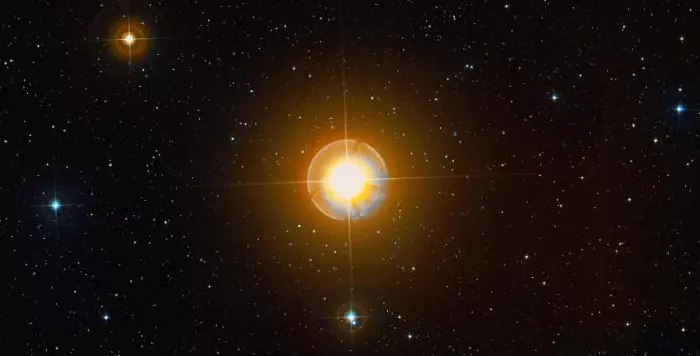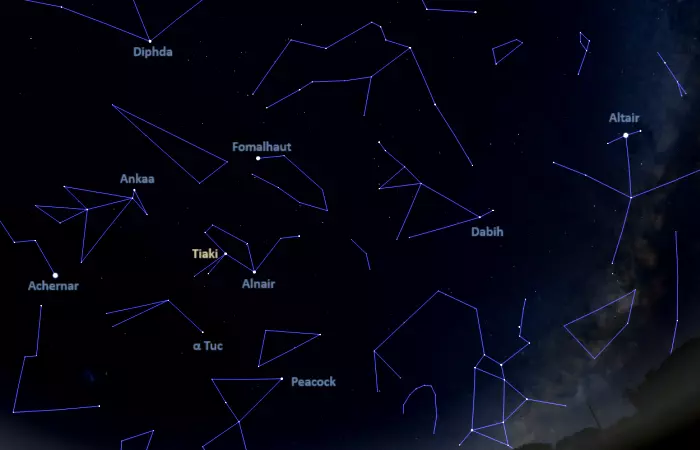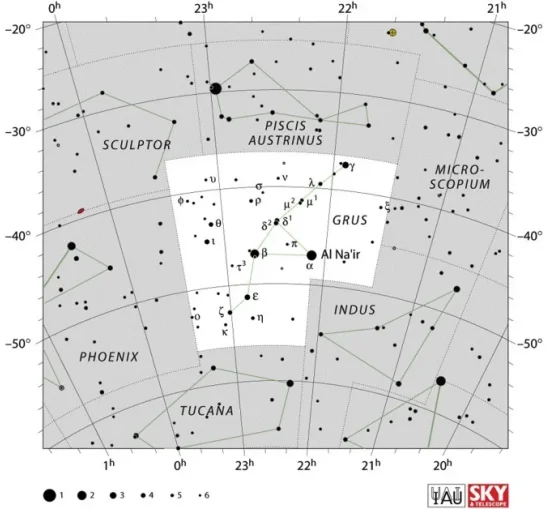Tiaki, Beta Gruis (β Gru) is a red giant star located approximately 177 light-years away in the constellation Grus (the Crane). With an apparent magnitude of 2.146, it is the second brightest star in the constellation, after Alnair. Both stars were once part of the neighbouring constellation Piscis Austrinus (the Southern Fish).
Star type
Tiaki is a red giant star of the spectral type M5 III. It has a mass of 2.4 solar masses and a radius 180 times that of the Sun. With a surface temperature of 3,480 K, it shines with 2,500 solar luminosities.
The star is currently on the asymptotic giant branch (AGB). It has a largely inert carbon-oxygen core and is fusing helium into carbon in a shell around the core and hydrogen into helium in another shell. Tiaki is not massive enough to go out as a supernova when it reaches the end of its life cycle. Instead, it will cast away its outer layers to form a planetary nebula and gradually cool and fade as a white dwarf.
Beta Gruis is classified as a semiregular variable (type SRb). Its brightness varies from magnitude 2.0 to 2.3. The giant star shows regular changes over a 37-day period as well as slow irregular variations. Semiregular variables are typically cooler evolved giant or supergiant stars that show periodicity in their brightness variations, but these periods are interrupted by irregular variations. Other stars in this class include La Superba in the constellation Canes Venatici, Brachium in Libra, Rho Persei in Perseus, R Lyrae in Lyra, and R Doradus in Dorado.

Tiaki (Beta Gruis), image: Wikisky
Facts
Tiaki was once part of the Greek constellation Piscis Austrinus (the Southern Fish). It was the rear star in the Southern Fish’s tail. The brighter Alnair and the fainter Delta, Theta, Iota, and Lambda Gruis were also considered part of Piscis Austrinus in medieval Arabic astronomy.
Beta Gruis is on average the 58th brightest star in the night sky. It is about as bright as Alpheratz and Mirach in the constellation Andromeda, Kochab in Ursa Minor, Saiph in Orion, and Rasalhague in Ophiuchus.
Name
The name Tiaki (pronunciation: /tiˈɑːki/) is the traditional name of Beta Gruis in the Tuamotuan language (Paʻumotu) of the Tuamotu archipelago in Polynesia. The International Astronomical Union’s (IAU) Working Group on Star Names (WGSN) approved the name on September 5, 2017.
In Chinese astronomy, Tiaki was known as 鶴二 (Hè èr), the Second Star of the Crane. The Crane was an asterism formed by Beta Gruis with Alnair (Alpha Gruis), Epsilon Gruis, Eta Gruis, Delta Tucanae, Zeta Gruis, Iota Gruis, Theta Gruis, Delta2 Gruis, and Mu1 Gruis.
Location
Tiaki is relatively easy to find because it appears in the same region of the sky as the bright Fomalhaut in Piscis Austrinus and Achernar in Eridanus. Tiaki appears west of the imaginary line connecting the two first-magnitude stars, near the brighter Alnair (Alpha Gruis).
Due to its location in the southern sky, the star is easier to observe from locations in the equatorial and southern latitudes. At declination -46°53’, the star is mostly invisible from the mid-northern latitudes. It may be spotted from locations immediately south of the latitude 42-43° N, depending on the geography, but it stays close to the horizon.

The location of Tiaki (Beta Gruis), image: Stellarium
Constellation
Tiaki is located in the constellation Grus. The celestial Crane is one of the four constellations collectively known as the Southern Birds. The other three are Pavo (the Peacock), Phoenix (the Phoenix), and Tucana (the Toucan).
Grus was created by the Dutch astronomer Petrus Plancius in the late 16th century. Plancius created the constellation from stars that formed the tail of the Southern Fish (Piscis Austrinus). He is also credited for creating Pavo, Phoenix, Tucana, and several other constellations that are named after the animals and subjects described by the 16th century Dutch navigators who explored the southern hemisphere. Grus first appeared in a star atlas in 1603, in German astronomer Johann Bayer’s Uranometria.

Grus constellation map by IAU and Sky&Telescope magazine
Grus occupies 366 square degrees of the southern sky and is the 45th largest of the 88 constellations. With three stars brighter than magnitude 3.0 – Alnair (Alpha Gruis), Tiaki (Beta Gruis), and Aldhanab (Gamma Gruis) – the constellation is easy to make out on a clear night.
Alnair, the constellation’s brightest star, is a hot B-type main sequence star that shines at magnitude 1.74 from a distance of 101 light-years. Aldhanab, a more evolved B-type star, has an apparent magnitude of 3.0 and lies 211 light-years away.
Other notable stars in Grus include the yellow giant Delta1 Gruis, the variable red giant Delta2 Gruis, the orange giants Iota and Zeta Gruis, the triple star system Theta Gruis, and Itonda (HD 208487), a Sun-like yellow dwarf with a confirmed exoplanet.
Grus contains a number of notable deep sky objects. These include the Grus Quartet of galaxies, the barred spiral galaxies NGC 7424 and NGC 7410, the lenticular galaxy NGC 7213, and the Spare Tyre Nebula, a planetary nebula catalogued as IC 5148.
The best time of the year to observe the stars and deep sky objects in Grus is during the month of October, when the constellation is higher above the horizon in the evening. The entire constellation is visible from locations south of the latitude 34° N.
The 10 brightest stars in Grus are Alnair (Alpha Gru, mag. 1.74), Tiaki (Beta Gru, mag. 2.0 – 2.3), Aldhanab (Gamma Gru, mag. 3.003), Epsilon Gruis (mag. 3.466), Iota Gruis (mag. 3.90), Delta1 Gruis (mag. 3.97), Delta2 Gruis (mag. 4.11), Zeta Gruis (mag. 4.12), Theta Gruis (mag. 4.28), and Lambda Gruis (mag. 4.47).
Tiaki – Beta Gruis
| Spectral class | M5 III or M4.5III |
| Variable type | Semiregular variable (SRb) |
| U-B colour index | +1.757 |
| B-V colour index | +1.620 |
| Apparent magnitude | 2.146 (2.0 – 2.3) |
| Absolute magnitude | −1.61 ± 0.052 |
| Distance | 177 ± 4 light-years (54 ± 1 parsecs) |
| Parallax | 18.43 ± 0.42 mas |
| Radial velocity | -0.30 ± 0.3 km/s |
| Proper motion | RA: +135.16 ± 0.44 mas/yr |
| Dec.: −4.38 ± 0.31 mas/yr | |
| Mass | 2.4 M☉ |
| Luminosity | 2,500 L☉ |
| Radius | 180 R☉ |
| Temperature | 3,480 K |
| Metallicity | 0.0 dex |
| Surface gravity | 0.4 cgs |
| Constellation | Grus |
| Right ascension | 22h 42m 40.05027s |
| Declination | −46° 53′ 04.4752″ |
| Names and designations | Tiaki, Beta Gruis, β Gru, HD 214952, HR 8636, HIP 112122, FK5 856, SAO 231258, CD−47 14308, CPD-47 9896, GC 31685, GCRV 14260, JP11 3525, GSC 08446-01644, PPM 328536, PLX 5494.00, IRAS 22396-4708, 2MASS J22424003-4653044, UBV 21723, TYC 8446-1644-1, AAVSO 2236-47 |